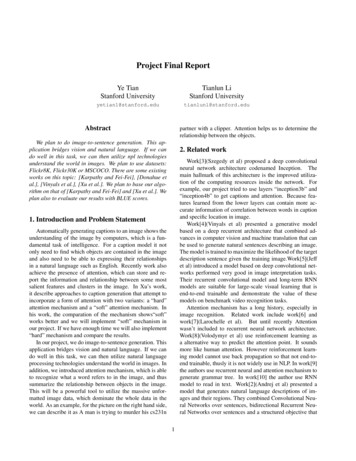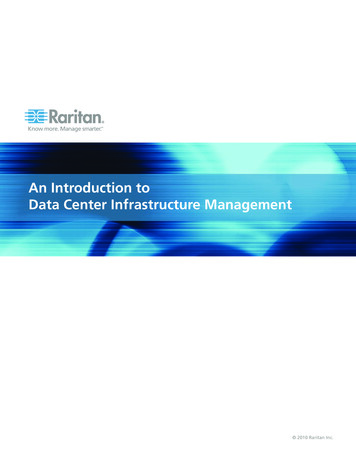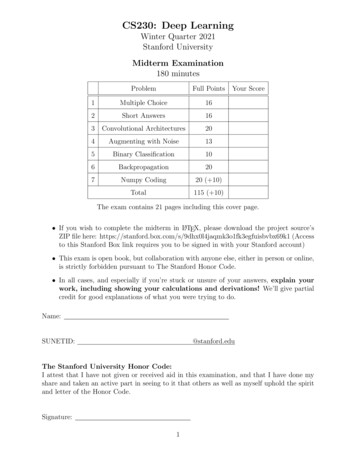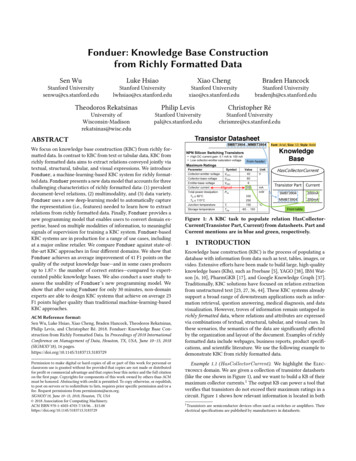
Transcription
iAn Introduction toStatistical Signal Processingf 1 (F )fFPr(f F ) P ({ω : ω F }) P (f 1 (F ))-January 4, 2011
iiAn Introduction toStatistical Signal ProcessingRobert M. GrayandLee D. DavissonInformation Systems LaboratoryDepartment of Electrical EngineeringStanford UniversityandDepartment of Electrical Engineering and Computer ScienceUniversity of Marylandc 2004 by Cambridge University Press. Copies of the pdf file may bedownloaded for individual use, but multiple copies cannot be made or printedwithout permission.
iiito our Families
ContentsPrefaceAcknowledgementsGlossary1 Introduction2 Probability2.1Introduction2.2Spinning pointers and flipping coins2.3Probability spaces2.4Discrete probability spaces2.5Continuous probability spaces2.6Independence2.7Elementary conditional probability2.8Problems3 Random variables, vectors, and processes3.1Introduction3.2Random variables3.3Distributions of random variables3.4Random vectors and random processes3.5Distributions of random vectors3.6Independent random variables3.7Conditional distributions3.8Statistical detection and classification3.9Additive noise3.10 Binary detection in Gaussian noise3.11 Statistical estimation3.12 Characteristic functions3.13 Gaussian random vectors3.14 Simple random processesvpage 32135142144145151152
vi456Contents3.15 Directly given random processes3.16 Discrete time Markov processes3.17 Nonelementary conditional probability3.18 ProblemsExpectation and averages4.1Averages4.2Expectation4.3Functions of random variables4.4Functions of several random variables4.5Properties of expectation4.6Examples4.7Conditional expectation4.8 Jointly Gaussian vectors4.9Expectation as estimation4.10 Implications for linear estimation4.11 Correlation and linear estimation4.12 Correlation and covariance functions4.13 The central limit theorem4.14 Sample averages4.15 Convergence of random variables4.16 Weak law of large numbers4.17 Strong law of large numbers4.18 Stationarity4.19 Asymptotically uncorrelated processes4.20 ProblemsSecond-order theory5.1Linear filtering of random processes5.2Linear systems I/O relations5.3Power spectral densities5.4Linearly filtered uncorrelated processes5.5Linear modulation5.6White noise5.7 Time averages5.8 Mean square calculus5.9 Linear estimation and filtering5.10 ProblemsA menagerie of processes6.1Discrete time linear models6.2Sums of iid random 92296299303331349363364369
Contents6.3Independent stationary increment processes6.4 Second-order moments of isi processes6.5Specification of continuous time isi processes6.6Moving-average and autoregressive processes6.7The discrete time Gauss–Markov process6.8Gaussian random processes6.9The Poisson counting process6.10 Compound processes6.11 Composite random processes6.12 Exponential modulation6.13 Thermal noise6.14 Ergodicity6.15 Random fields6.16 ProblemsAppendix A PreliminariesA.1 Set theoryA.2 Examples of proofsA.3 Mappings and functionsA.4 Linear algebraA.5 Linear system fundamentalsA.6 ProblemsAppendix B Sums and integralsB.1SummationB.2 Double sumsB.3IntegrationB.4 The Lebesgue integralAppendix C Common univariate distributionsAppendix D Supplementary 443446448453457
PrefaceThe origins of this book lie in our earlier book Random Processes: A Mathematical Approach for Engineers (Prentice Hall, 1986). This book began asa second edition to the earlier book and the basic goal remains unchanged– to introduce the fundamental ideas and mechanics of random processes toengineers in a way that accurately reflects the underlying mathematics, butdoes not require an extensive mathematical background and does not belabor detailed general proofs when simple cases suffice to get the basic ideasacross. In the years since the original book was published, however, it hasevolved into something bearing little resemblance to its ancestor. Numerous improvements in the presentation of the material have been suggestedby colleagues, students, teaching assistants, and reviewers, and by our ownteaching experience. The emphasis of the book shifted increasingly towardsexamples and a viewpoint that better reflected the title of the courses wetaught using the book for many years at Stanford University and at theUniversity of Maryland: An Introduction to Statistical Signal Processing.Much of the basic content of this course and of the fundamentals of randomprocesses can be viewed as the analysis of statistical signal processing systems: typically one is given a probabilistic description for one random object,which can be considered as an input signal. An operation is applied to theinput signal (signal processing) to produce a new random object, the outputsignal. Fundamental issues include the nature of the basic probabilistic description, and the derivation of the probabilistic description of the outputsignal given that of the input signal and the particular operation performed.A perusal of the literature in statistical signal processing, communications,control, image and video processing, speech and audio processing, medical signal processing, geophysical signal processing, and classical statisticalareas of time series analysis, classification and regression, and pattern recognition shows a wide variety of probabilistic models for input processes andix
xPrefacefor operations on those processes, where the operations might be deterministic or random, natural or artificial, linear or nonlinear, digital or analog, orbeneficial or harmful. An introductory course focuses on the fundamentalsunderlying the analysis of such systems: the theories of probability, randomprocesses, systems, and signal processing.When the original book went out of print, the time seemed ripe to convertthe manuscript from the prehistoric troff format to the widely used LATEXformat and to undertake a serious revision of the book in the process. As therevision became more extensive, the title changed to match the course nameand content. We reprint the original preface to provide some of the originalmotivation for the book, and then close this preface with a description ofthe goals sought during the many subsequent revisions.Preface to Random Processes: An Introduction for EngineersNothing in nature is random . . . A thing appears random onlythrough the incompleteness of our knowledge.Spinoza, Ethics II do not believe that God rolls dice.attributed to EinsteinLaplace argued to the effect that given complete knowledge of the physics of anexperiment, the outcome must always be predictable. This metaphysical argumentmust be tempered with several facts. The relevant parameters may not be measurable with sufficient precision due to mechanical or theoretical limits. For example,the uncertainty principle prevents the simultaneous accurate knowledge of both position and momentum. The deterministic functions may be too complex to computein finite time. The computer itself may make errors due to power failures, lightning,or the general perfidy of inanimate objects. The experiment could take place in aremote location with the parameters unknown to the observer; for example, in acommunication link, the transmitted message is unknown a priori, for if it were not,there would be no need for communication. The results of the experiment could bereported by an unreliable witness – either incompetent or dishonest. For these andother reasons, it is useful to have a theory for the analysis and synthesis of processes that behave in a random or unpredictable manner. The goal is to constructmathematical models that lead to reasonably accurate prediction of the long-termaverage behavior of random processes. The theory should produce good estimatesof the average behavior of real processes and thereby correct theoretical derivationswith measurable results.In this book we attempt a development of the basic theory and applications ofrandom processes that uses the language and viewpoint of rigorous mathematicaltreatments of the subject but which requires only a typical bachelor’s degree level ofelectrical engineering education including elementary discrete and continuous timelinear systems theory, elementary probability, and transform theory and applica-
Prefacexitions. Detailed proofs are presented only when within the scope of this background.These simple proofs, however, often provide the groundwork for “handwaving” justifications of more general and complicated results that are semi-rigorous in thatthey can be made rigorous by the appropriate delta-epsilontics of real analysis ormeasure theory. A primary goal of this approach is thus to use intuitive argumentsthat accurately reflect the underlying mathematics and which will hold up underscrutiny if the student continues to more advanced courses. Another goal is to enable the student who might not continue to more advanced courses to be able toread and generally follow the modern literature on applications of random processesto information and communication theory, estimation and detection, control, signalprocessing, and stochastic systems theory.RevisionsThrough the years the original book has continually expanded to roughlydouble its original size to include more topics, examples, and problems. Thematerial has been significantly reorganized in its grouping and presentation.Prerequisites and preliminaries have been moved to the appendices. Majoradditional material has been added on jointly Gaussian vectors, minimummean squared error estimation, linear and affine least squared error estimation, detection and classification, filtering, and, most recently, mean squarecalculus and its applications to the analysis of continuous time processes.The index has been steadily expanded to ease navigation through the book.Numerous errors reported by reader email have been fixed and suggestionsfor clarifications and improvements incorporated.This book is a work in progress. Revised versions will be made availablethrough the World Wide Web page http://ee.stanford.edu/ gray/sp.html.The material is copyrighted by Cambridge University Press, but is freelyavailable as a pdf file to any individuals who wish to use it provided onlythat the contents of the entire text remain intact and together. Comments,corrections, and suggestions should be sent to rmgray@stanford.edu. Everyeffort will be made to fix typos and take suggestions into account on at leastan annual basis.
AcknowledgementsWe repeat our acknowledgements of the original book: to Stanford University and the University of Maryland for the environments in which thebook was written, to the John Simon Guggenheim Memorial Foundationfor its support of the first author during the writing in 1981–2 of the original book, to the Stanford University Information Systems Laboratory Industrial Affiliates Program which supported the computer facilities used tocompose this book, and to the generations of students who suffered throughthe ever changing versions and provided a stream of comments and corrections. Thanks are also due to Richard Blahut and anonymous refereesfor their careful reading and commenting on the original book. Thanks aredue to the many readers who have provided corrections and helpful suggestions through the Internet since the revisions began being posted. Particularthanks are due to Yariv Ephraim for his continuing thorough and helpfuleditorial commentary. Thanks also to Sridhar Ramanujam, Raymond E.Rogers, Isabel Milho, Zohreh Azimifar, Dan Sebald, Muzaffer Kal, GregCoxson, Mihir Pise, Mike Weber, Munkyo Seo, James Jacob Yu, and severalanonymous reviewers for Cambridge University Press. Thanks also to PhilipMeyler, Lindsay Nightingale, and Joseph Bottrill of Cambridge UniversityPress for their help in the production of the final version of the book. Thanksto the careful readers who informed me of typos and mistakes in the bookfollowing its publication, all of which have been reported and fixed in the errata (http://ee.stanford.edu/ gray/sperrata.pdf) and incorporated into theelectronic version: Ian Lee, Michael Gutmann, André Isidio de Melo, andespecially Ron Aloysius, who has contributed greatly to the fixing of typos.Lastly, the first author would like to acknowledge his debt to his professors who taught him probability theory and random processes, especially AlDrake and Wilbur B. Davenport Jr. at MIT and Tom Pitcher at USC.xii
Glossary{}[]()( ], [ ) Ω#(F )a collection of points satisfying some property, e.g. {r :r a} is the collection of all real numbers less than orequal to a value aan interval of real points including the end points, e.g.for a b [a, b] {r : a r b}. Called a closed intervalan interval of real points excluding the end points, e.g.for a b (a, b) {r : a r b}. Called an open interval. Note this is empty if a bdenote intervals of real points including one endpointand excluding the other, e.g. for a b (a, b] {r : a r b}, [a, b) {r : a r b}the empty set, the set that contains no points.for allthe sample space or universal set, the set that containsall of the pointsthe number of elements in a set F equal by definitionexpthe exponential function, exp(x) ex , used for claritywhen x is complicatedsigma-field or event spaceBorel field of Ω, that is, the sigma-field of subsets ofthe real line generated by the intervals or the Cartesianproduct of a collection of such sigma-fieldsif and only iflimit in the meanfunction of u that goes to zero as u 0 faster than uFB(Ω)iffl.i.m.o(u) xiii
xivGlossaryPPXpXfXΦQprobability measuredistribution of a random variable or vector Xprobability mass function (pmf) of a random variable Xprobability density function (pdf) of a random variableXcumulative distribution function (cdf) of a random variable Xexpectation of a random variable Xcharacteristic function of a random variable Xaddition modulo 2indicator function of a set F : 1F (x) 1 if x F and 0otherwiseΦ-function (Eq. (2.78))complementary Phi function (Eq. (2.79))Zk {0, 1, 2, . . . , k 1}FXE(X)MX (ju) 1F (x)Z Z {0, 1, 2, . . .}, the collection of nonnegative integers {. . . , 2, 1, 0, 1, 2, . . .}, the collection of all integers
1IntroductionA random or stochastic process is a mathematical model for a phenomenonthat evolves in time in an unpredictable manner from the viewpoint of theobserver. The phenomenon may be a sequence of real-valued measurementsof voltage or temperature, a binary data stream from a computer, a modulated binary data stream from a modem, a sequence of coin tosses, thedaily Dow–Jones average, radiometer data or photographs from deep spaceprobes, a sequence of images from a cable television, or any of an infinitenumber of possible sequences, waveforms, or signals of any imaginable type.It may be unpredictable because of such effects as interference or noise in acommunication link or storage medium, or it may be an information-bearingsignal, deterministic from the viewpoint of an observer at the transmitterbut random to an observer at the receiver.The theory of random processes quantifies the above notions so thatone can construct mathematical models of real phenomena that are bothtractable and meaningful in the sense of yielding useful predictions of future behavior. Tractability is required in order for the engineer (or anyoneelse) to be able to perform analyses and syntheses of random processes, perhaps with the aid of computers. The “meaningful” requirement is that themodels must provide a reasonably good approximation of the actual phenomena. An oversimplified model may provide results and conclusions thatdo not apply to the real phenomenon being modeled. An overcomplicatedone may constrain potential applications, render theory too difficult to beuseful, and strain available computational resources. Perhaps the most distinguishing characteristic between an average engineer and an outstandingengineer is the ability to derive effective models providing a good balancebetween complexity and accuracy.Random processes usually occur in applications in the context of environments or systems which change the processes to produce other processes.1
2IntroductionThe intentional operation on a signal produced by one process, an “inputsignal,” to produce a new signal, an “output signal,” is generally referred toas signal processing, a topic easily illustrated by examples.r A time-varying voltage waveform is produced by a human speaking into a microphone or telephone. The signal can be modeled by a random process. Thissignal might be modulated for transmission, then it might be digitized and codedfor transmission on a digital link. Noise in the digital link can cause errors inreconstructed bits, the bits can then be used to reconstruct the original signalwithin some fidelity. All of these operations on signals can be considered as signalprocessing, although the name is most commonly used for manmade operationssuch as modulation, digitization, and coding, rather than the natural possiblyunavoidable changes such as the addition of thermal noise or other changes outof our control.r For digital speech communications at very low bit rates, speech is sometimesconverted into a model consisting of a simple linear filter (called an autoregressivefilter) and an input process. The idea is that the parameters describing the modelcan be communicated with fewer bits than can the original signal, but the receivercan synthesize the human voice at the other end using the model so that it soundsvery much like the original signal. A system of this type is called a vocoder .r Signals including image data transmitted from remote spacecraft are virtuallyburied in noise added to them on route and in the front end amplifiers of thereceivers used to retrieve the signals. By suitably preparing the signals prior totransmission, by suitable filtering of the received signal plus noise, and by suitabledecision or estimation rules, high quality images are transmitted through this verypoor channel.r Signals produced by biomedical measuring devices can display specific behaviorwhen a patient suddenly changes for the worse. Signal processing systems can lookfor these changes and warn medical personnel when suspicious behavior occurs.r Images produced by laser cameras inside elderly North Atlantic pipelines canbe automatically analyzed to locate possible anomalies indicating corrosion bylooking for locally distinct random behavior.How are these signals characterized? If the signals are random, how does onefind stable behavior or structures to describe the processes? How do operations on these signals change them? How can one use observations based onrandom signals to make intelligent decisions regarding future behavior? Allof these questions lead to aspects of the theory and application of randomprocesses.Courses and texts on random processes usually fall into either of twogeneral and distinct categories. One category is the common engineeringapproach, which involves fairly elementary probability theory, standard un-
Introduction3dergraduate Riemann calculus, and a large dose of “cookbook” formulas –often with insufficient attention paid to conditions under which the formulas are valid. The results are often justified by nonrigorous and occasionallymathematically inaccurate handwaving or intuitive plausibility argumentsthat may not reflect the actual underlying mathematical structure and maynot be supportable by a precise proof. While intuitive arguments can beextremely valuable in providing insight into deep theoretical results, theycan be a handicap if they do not capture the essence of a rigorous proof.A development of random processes that is insufficiently mathematicalleaves the student ill prepared to generalize the techniques and results whenfaced with a real-world example not covered in the text. For example, ifone is faced with the problem of designing signal processing equipment forpredicting or communicating measurements being made for the first timeby a space probe, how does one construct a mathematical model for thephysical process that will be useful for analysis? If one encounters a processthat is neither stationary nor ergodic (terms we shall consider in detail),what techniques still apply? Can the law of large numbers still be used toconstruct a useful model?An additional problem with an insufficiently mathematical development isthat it does not leave the student adequately prepared to read modern literature such as the many Transactions of the IEEE and the journals of the European Association for Signal, Speech, and Image Processing (EURASIP).The more advanced mathematical language of recent work is increasinglyused even in simple cases because it is precise and universal and focuses onthe structure common to all random processes. Even if an engineer is notdirectly involved in research, knowledge of the current literature can oftenprovide useful ideas and techniques for tackling specific problems. Engineersunfamiliar with basic concepts such as sigma-field and conditional expectation will find many potentially valuable references shrouded in mystery.The other category of courses and texts on random processes is the typicalmathematical approach, which requires an advanced mathematical background of real analysis, measure theory, and integration theory. This approach involves precise and careful theorem statements and proofs, and usesfar more care to specify precisely the conditions required for a result tohold. Most engineers do not, however, have the required mathematical background, and the extra care required in a completely rigorous developmentseverely limits the number of topics that can be covered in a typical course– in particular, the applications that are so important to engineers tend tobe neglected. In addition, too much time is spent with the formal details,
4Introductionobscuring the often simple and elegant ideas behind a proof. Often little, ifany, physical motivation for the topics is given.This book attempts a compromise between the two approaches by givingthe basic theory and a profusion of examples in the language and notationof the more advanced mathematical approaches. The intent is to make thecrucial concepts clear in the traditional elementary cases, such as coin flipping, and thereby to emphasize the mathematical structure of all randomprocesses in the simplest possible context. The structure is then further developed by numerous increasingly complex examples of random processesthat have proved useful in systems analysis. The complicated examples areconstructed from the simple examples by signal processing, that is, by usinga simple process as an input to a system whose output is the more complicated process. This has the double advantage of describing the action ofthe system, the actual signal processing, and the interesting random processwhich is thereby produced. As one might suspect, signal processing also canbe used to produce simple processes from complicated ones.Careful proofs are usually constructed only in elementary cases. For example, the fundamental theorem of expectation is proved only for discreterandom variables, where it is proved simply by a change of variables in asum. The continuous analog is subsequently given without a careful proof,but with the explanation that it is simply the integral analog of the summation formula and hence can be viewed as a limiting form of the discreteresult. As another example, only weak laws of large numbers are proved indetail in the mainstream of the text, but the strong law is treated in detailfor a special case in a starred section. Starred sections are used to delveinto other relatively advanced results, for example the use of mean squareconvergence ideas to make rigorous the notion of integration and filtering ofcontinuous time processes.By these means we strive to capture the spirit of important proofs without undue tedium and to make plausible the required assumptions and constraints. This, in turn, should aid the student in determining when certaintools do or do not apply and what additional tools might be necessary whennew generalizations are required.A distinct aspect of the mathematical viewpoint is the “grand experiment”view of random processes as being a probability measure on sequences (fordiscrete time) or waveforms (for continuous time) rather than being an infinity of smaller experiments representing individual outcomes (called randomvariables) that are somehow glued together. From this point of view randomvariables are merely special cases of random processes. In fact, the grand ex-
Introduction5periment viewpoint was popular in the early days of applications of randomprocesses to systems and was called the “ensemble” viewpoint in the work ofNorbert Wiener and his students. By viewing the random process as a wholeinstead of as a collection of pieces, many basic ideas, such as stationarityand ergodicity, that characterize the dependence on time of probabilistic descriptions and the relation between time averages and probabilistic averagesare much easier to define and study. This also permits a more complete discussion of processes that violate such probabilistic regularity requirementsyet still have useful relations between time and probabilistic averages.Even though a student completing this book will not be able to followthe details in the literature of many proofs of results involving random processes, the basic results and their development and implications should beaccessible, and the most common examples of random processes and classesof random processes should be familiar. In particular, the student shouldbe well equipped to follow the gist of most arguments in the various Transactions of the IEEE dealing with random processes, including the IEEETransactions on Signal Processing, IEEE Transactions on Image Processing,IEEE Transactions on Speech and Audio Processing, IEEE Transactions onCommunications, IEEE Transactions on Control, and IEEE Transactionson Information Theory, and the EURASIP/Elsevier journals such as ImageCommunication, Speech Communication, and Signal Processing.It also should be mentioned that the authors are electrical engineers and,as such, have written this text with an electrical engineering flavor. However, the required knowledge of classical electrical engineering is slight, andengineers in other fields should be able to follow the material presented.This book is intended to provide a one-quarter or one-semester coursethat develops the basic ideas and language of the theory of random processes and provides a rich collection of examples of commonly encounteredprocesses, properties, and calculations. Although in some cases these examples may seem somewhat artificial, they are chosen to illustrate the wayengineers should think about random processes. They are selected for simplicity and conceptual content rather than to present the method of solutionto some particular application. Sections that can be skimmed or omitted forthe shorter one-quarter curriculum are marked with a star ( ). Discrete timeprocesses are given more emphasis than in many texts because they are simpler to handle and because they are of increasing practical importance indigital systems. For example, linear filter input/output relations are carefullydeveloped for discrete time; then the continuous time analogs are obtained
6Introductionby replacing sums with integrals. The mathematical details underlying thecontinuous time results are found in a starred section.Most examples are developed by beginning with simple processes. Theseprocesses are filtered or modulated to obtain more complicated processes.This provides many examples of typical probabilistic computations on simpleprocesses and on the output of operations on simple processes. Extra toolsare introduced as needed to develop properties of the examples.The prerequisites for this book are elementary set theory, elementary probability, and some familiarity with linear systems theory (Fourier analysis,convolution, discrete and continuous time linear filters, and transfer functions). The elementary set theory and probability may be found, for example,in the classic text by Al Drake [18] or in the current MIT basic probabilitytext by Bertsekas and Tsitsiklis [3]. The Fourier and linear systems materialcan by found in numerous texts, including Gray and Goodman [33]. Some ofthese basic topics are reviewed in this book in Appendix A. These results areconsidered prerequisite as the pace and density of material would likely beoverwhelming to someone not already familiar with the fundamental ideasof probability such as probability mass and density functions (including themore common named distributions), computing probabilities, derived distributions, random variables, and expectation. It has long been the authors’experience that the students having the most difficulty with this materialare those with little or no experience with elementary probability.Organization of the bookChapter 2 provides a careful development of the fundamental concept ofprobability theory – a probability space or experiment. The notions of sample space, event space, and probability measure are introduced and illustrated by examples. Independence and elementary conditional probabilityare developed in some detail. The ideas of signal processing and of randomvariables are introduced briefly as functions or operations on the output ofan experiment. This in turn allows mention of the idea of expectation at anearly stage as a generalization of the description of probabilities by sums orintegrals.Chapter 3 treats the theory of measurements made on experiments:random variables, which are scalar-valued measure
1 Introduction 1 2 Probability 10 2.1 Introduction 10 2.2 Spinning pointers and flipping coins 14 2.3 Probability spaces 22 2.4 Discrete probability spaces 44 2.5 Continuous probability spaces 54 2.6 Independence 68 2.7 Elementary conditional probability 70 2.8 Problems 73 3 Random variables, vectors, and processes 82 3.1 Introduction 82










